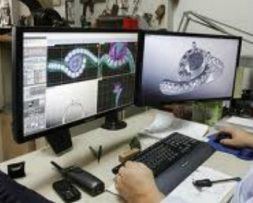NEWS
Jewelry shoppers find store a real gem as customers describe what they're looking for, technology helps owners design it on the spot By Marton Dunai
CONTRA COSTA TIMES & THE WALL STREET JOURNAL

Before retiring three years ago, Chip Hollister spent 40 years working as a machinist at the Lawrence Berkeley National Laboratory. He created hardware that scientists and graduate students dreamed up, often building parts from scratch.
"The big shots came to us with their computer drawings, and we had this machine that would create the parts from plastic," he said.
Hollister experienced a bit of deja vu recently. He married for a second time, and his wedding ring was modeled on a computer, then built out of wax, then cast out of gold and finished with stones -- all in a span of a few days. Just like the way he and his colleagues once made the advanced machines.
"It's fun stuff," he said of the gear at JewelSmiths, a jewelry studio in Pleasant Hill. "The kind of equipment they have must cost a heck of a lot of money, but what they can do in return nobody else can do."
As three-dimensional computer-aided design, or CAD, has become more accessible and cheaper in the past decade, its use has spread from large industries and Hollywood movies to smaller-scale businesses that deal with expensive materials or complicated structures. Sunglasses, specialty shoes or custom-made yachts are often designed with CAD.
It is becoming more popular with jewelers, who have profited from the ability to reduce their inventories to near zero, and decrease material costs and production times, as well as the creativity it gives them.
JewelSmiths, with its array of cutting-edge technology, is among the most advanced jewelry studios in the world, according to experts in the field. Owner Greg Stopka designs rings right in front of his customers with a computer modeling program that allows buyers to have full control over the kind of jewelry they want made.
"You have to be really quick to give the customer the impression that you're literally creating the model while they describe it," Stopka said on a recent afternoon, demonstrating his 3D-wizardry. The cursor on his flat panel screen moved faster than a layman could follow, but the hollow black void on the screen quickly gave way to a ringlike vector grid, then a ring shape, and then what looked like a crude computer rendering of a piece of jewelry. Finally Stopka applied the last layer of data, and the image almost jumped off the screen.
"It's the wow factor," he said. "I can even put the digital ring on a digital hand. My customers start to look at their own hands, then the computerized hand, then back at their own hands ... "
That's when customers' vague ideas become a specific desire. Satisfying that desire is how Stopka sells many rings for about $2,000 apiece, but sometimes closer to $10000.
One time, a Texan "the size of a buffalo" came and told Stopka about his dream design, a thick ring with rows of triangle diamonds along the sides. When Stopka put together a sketch on screen, the giant broke down crying.
"He told me he had looked for the ring for his wife for 12 full years," Stopka said, pointing at the archived original design that he had pulled up on his computer.
Hollister, a rugged man in his early 60s, has a similar story. He got divorced right around the same time he laid down the hammer at Lawrence Berkeley. He ran into Susie, his childhood sweetheart, after more than four decades, and promptly fell in love again. The couple decided to marry soon, determined to live happily ever after. But formalities proved to be a problem.
"I have looked at men's rings all my life, every last one of them, but they didn't turn me on. I had no idea what I wanted, I only knew what I didn't want," Hollister said. He went from mall to mall, from jeweler to jeweler, but never saw anything he liked.
Susie found a nice ring in Sun Valley Mall, but Chip struggled. About to lose hope, he finally saw Stopka's ad in a spring issue of Diablo Magazine and decided to visit the jeweler in a last effort.
What he saw blew him away. In the store, a slide show of completely unique designs ran on a flat panel TV mounted on the back wall. Framed photos of more unique designs adorned the walls of the small studio. To the right of the entrance stood a workshop, separated from the customer area by a glass wall, full of machinery that interested Hollister almost more than the ring itself. He knew he'd found something special.
During the next few days, Hollister familiarized himself with the technology in the jewelry shop -- according to Stopka, most men get excited about the $100,000 worth of stuff -- and returned time and again to fine tune the design. He saw the wax model Stopka made in his grower -- a 3-D version of a jet printer that uses wax instead of ink -- and bought the necessary diamonds on the Internet according to the jeweler's specifications.
The result was a two-tone ring, the gold and palladium bands slightly squared and separated, their gap bridged by a large princess diamond on top and three smaller gems down the sides. The base design for the ring had won Stopka top awards at a 2005 design contest in Atlanta.
"My friends tell me I should be careful, because a ring like that can get my finger cut off," Hollister boasted. But, he added, "everything I've ever done in my life has been on the more unique side."
According to industry insiders, CAD is just starting to penetrate the mainstream jewelry market. The early adopters have been the tech-savvy, but now many independent mall jewelry stores and small mom-and-pop shops have chosen to go digital.
"There's still a long way to go, but we see good indication that a huge majority of the industry will use this technology," said industry spokesperson Ryan Koning.
Steve Workman, who teaches CAD technologies to upcoming jewelers at the Gemological Institute of America in Carlsbad, says he has made the switch to digital design almost completely, putting to rest the tools he had used since he started working in 1973.
But the technology only makes sense for those who have a background in traditional jewelry. The Institute teaches technology as just another tool, he says, because there are things that the hand can do better, and things that the machine is superior at.
"Someone who's smart will do both," Workman said.
What makes digital designs perfect is also their Achilles' heel: They are based on computerized calculations, which are easy to emulate -- or to steal. "Some of my former students, who work on Rodeo Drive in Los Angeles, complain that their designs spend less than a week in a store window before popping up in competing stores," Workman said.
Stopka knows that, but he says he won't go after makers of knockoffs. He tries his best to protect his intellectual rights: His designs go into his digital vault, never to be used again. Still, there's little real defense against piracy. The one sure way to fend off mimics is creating a unique style. "If people look at a ring and say, that's a Stopka design, I won't have to worry about knockoffs," he said.
Lorrel Birnschein, an attorney at a San Francisco firm recently got to touch the finished product she had dreamed up with her fiance, Michael Plimier, a lawyer at Intel.
"Pretty heavy, huh?" Birnschein said. "I'm going to wear it soon as we get out of this store."
Stopka had already closed. The couple were the only customers in the store, standing in silence and weighing the moment for a while. Once they left, Stopka and his wife, Lee, looked at each other.
"I love this job," Lee said. "You see so many happy people."

